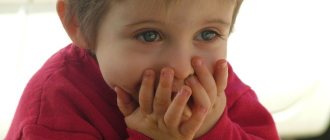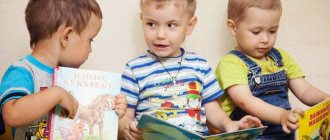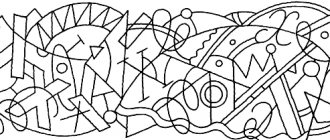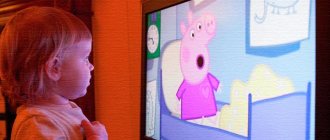The state of general speech underdevelopment (GSD) is characterized by a violation of all aspects of the formation of speech skills.
Its main distinguishing feature is the presence of problems both with the sound side (pronunciation), and with lexical and grammatical aspects. At the same time, children with general speech underdevelopment do not have hearing or intellectual impairments. Distinctive features of OHP:
- The presence of problems both with the pronunciation of sounds and with the skills of coherent expressive speech, mastering the rules of grammatical structure and a poor active vocabulary.
- Hearing is not impaired. A specialist check is required.
- Primary intelligence is normal. That is, a child at birth does not have a diagnosis of “mental retardation,” etc. However, it is worth keeping in mind that long-term uncorrected mental retardation can also lead to mental retardation.
It is possible to talk about the presence of general speech underdevelopment in a child only after 3-4 years. Until this time, children develop differently and “have the right” to some deviations from average norms. Everyone has their own pace of speech formation. But after 3, it’s worth paying attention to how the child speaks. It is quite possible that he needs the help of a speech therapist.
The manifestation of OHP in children is expressed differently based on their depth of impairment.
General speech underdevelopment level 1
A violation of this degree means an almost complete absence of speech in the child. Problems are visible to what is called the “naked eye.”
What does it show:
- A child's active vocabulary is very poor. To communicate, he uses mainly babbling words, the first syllables of words, and onomatopoeia. At the same time, he is not at all averse to communicating, but in “his” language. A cat means “meow”, “beep” can mean a car, a train, or the process of driving itself.
- Gestures and facial expressions are widely used. They are always appropriate, carry a specific meaning and, in general, help the child communicate.
- Simple sentences either simply do not exist in the child’s speech, or may consist of two amorphous words combined in meaning. “Meow bee bee” during the game will mean that the cat drove the car. “Woof di” means both the dog is walking and the dog is running.
- At the same time, the passive vocabulary significantly exceeds the active one. The child understands spoken speech to a much greater extent than he can say himself.
- Compound words (consisting of several syllables) are abbreviated. For example, bus sounds like "abas" or "atobu". This indicates that phonemic hearing is unformed, that is, the child does not distinguish individual sounds well.
BOOKS
Babushkina R.L. Speech therapy rhythm: Methodology for working with preschoolers suffering from OHP / R.L. Babushkina, O.M. Kislyakova.
- St. Petersburg. : Karo, 2005. - 176 p. - (Correctional pedagogy). Kondratenko I. Yu. Formation of emotional vocabulary in preschool children with general speech underdevelopment: Monograph. - St. Petersburg. : Karo, 2006. - 238 p.
Sazonova S. N. Speech development of preschool children with general speech underdevelopment. — 2nd ed., rev. - M.: Academia, 2005. - 144 p.
Collection of notes from speech therapy sessions on speech development for children with special needs: special. appl. to the journal “School.” speech therapist". - M.: Education Plus, 2007. - 107 p.
Smirnova L.N. Speech therapy in kindergarten: Classes with children 6-7 years old with OHP: A manual for speech therapists, defectologists and educators. - M.: Mozaika-Sintez, 2006. - 95 p. - (Teacher's Library).
Filicheva T. B. Elimination of general speech underdevelopment in preschool children: Practical work. allowance / T. B. Filicheva, G. V. Chirkina. – Ed. 3rd. – M.: Iris-press; Iris-didactics, 2005. – 212 p. – (Library of speech therapist-practitioner).
General speech underdevelopment level 2
The main striking difference from level 1 is the constant presence in the child’s speech of a certain number of commonly used words, although not yet pronounced very correctly. At the same time, the beginnings of the formation of a grammatical connection between words are noticeable, although not yet permanent.
What to pay attention to:
- The child always uses the same word, denoting a specific object or action in a distorted form. For example, apple will always sound like “lyabako” in any context.
- The active dictionary is quite poor. The child does not know words denoting the characteristics of an object (shape, its individual parts).
- There is no skill in combining objects into groups (a spoon, plate, pan are utensils). Objects that are similar in some way can be called in one word.
- Sound pronunciation is also far behind. The child pronounces many sounds poorly.
- A characteristic feature of level 2 OHP is the appearance in speech of the rudiments of a grammatical change in spoken words depending on the number. However, the child can only cope with simple words even if the ending is stressed (go - goUt). Moreover, this process is unstable and does not always manifest itself.
- Simple sentences are actively used in speech, but the words in them are not consistent with each other. For example, “papa pitya” - dad came, “guyai gokam” - walked on the hill, etc.
- Prepositions in speech may be completely missed or used incorrectly.
- A coherent story - based on a picture or with the help of an adult's questions - is already obtained, in contrast to the state at level 1 OHP, but it is very limited. Basically, the child uses two-syllable, inconsistent sentences consisting of a subject and a predicate. “Guyai gokam. Videy seg. Ipiy segika." (Walked on a hill, saw snow, made a snowman).
- The syllabic structure of polysyllabic words is disrupted. As a rule, syllables are not only distorted due to incorrect pronunciation, but also rearranged and simply thrown out. (Boots are “bokiti”, people are “tevek”).
Periodization of OHP according to R.E. Levina.
⇐ PreviousPage 42 of 47Next ⇒
GSD, general speech underdevelopment - various complex speech disorders in which the formation of all components of the speech system is impaired, i.e. the sound side (phonetics) and the semantic side (vocabulary, grammar).
The term OHP was first introduced in the 50-60s of the 20th century by the founder of preschool speech therapy in Russia R.E. Levina.
The causes of general speech underdevelopment (GSD) are various adverse effects both in the prenatal period of development (intoxication, toxicosis) and during childbirth (birth trauma, asphyxia), as well as in the first years of the child’s life.
General underdevelopment of speech can be observed in complex forms of childhood speech pathology: alalia, aphasia (always), as well as rhinolalia, dysarthria.
Levina identified characteristic features indicating systemic disorders of speech activity:
• Later onset of speech: the first words appear by 3-4, and sometimes by 5 years;
• Severe limitation of vocabulary;
• Sound pronunciation defects;
• Speech is ungrammatical;
• phonemic hearing impairment;
• violation of the rhythmic-syllabic structure of the word;
• Difficulty in distributing simple sentences and constructing complex ones.
R.E. Levina identified three levels of speech development, which reflect the typical state of language components in children with SLD:
• The first level of speech development is characterized by:
• Lack of commonly used speech (the so-called “speechless children”).
• Such children use “babble” words and sound imitations. Depending on the situation, babbling formations can be regarded as one-word sentences.
• Children accompany “statements” with facial expressions and gestures. For example, “bi-bi” can mean an airplane, a dump truck, or a steamship.
• Children use the same complex to designate objects, actions, qualities, indicating the difference in meaning with intonation and gestures.
• There is almost no differentiated designation of objects and actions. The names of actions are replaced by the names of objects (to open - “tree” (door), and vice versa - the names of objects are replaced by the names of actions (bed - “stale”). The polysemy of the words used is characteristic.
• Second level of speech development.
The beginnings of common speech.
• In addition to gestures and “babbling” words, although distorted, fairly constant commonly used words appear. For example, “lyaboka” instead of “apple”.
• Children's pronunciation abilities and vocabulary are significantly behind the age norm.
• The syllable structure is disrupted. For example, the most typical reduction in the number of syllables is “teviki” instead of “snowmen”.
• Children use only simple sentences consisting of 2-3, rarely 4 words.
• Children do not know the names of the color of an object, its shape, size, and replace words with similar meanings.
• There are gross errors in the use of grammatical structures:
- mixing of case forms (“driving a car” instead of in a car;
- often the use of nouns in the nominative case, and verbs in the infinitive or the 3rd person singular and plural form of the present tense;
- in the use of number and gender of verbs, when changing nouns by number (“two taxis” - two pencils, “de tun” - two chairs);
- lack of agreement between adjectives and nouns
— The phonetic side of speech is characterized by the presence of numerous distortions of sounds, substitutions and confusions
- The pronunciation of soft and hard sounds, hissing, whistling, affricates, voiced and voiceless sounds is impaired (“pat book” - five books; “paputka” - grandmother; “dupa” - hand).
— The sound filling of syllables, sounds, replacement and assimilation of syllables (“morshki” - daisies. “kukika” - strawberries) is disrupted. Polysyllabic words are reduced.
• The third level of speech development is characterized by:
• the presence of extensive phrasal speech with elements of lexico-grammatical and phonetic-phonemic underdevelopment
• Characteristic is the undifferentiated pronunciation of sounds (mainly whistling, hissing, affricates and sonorators), when one sound simultaneously replaces two or more sounds of a given or similar phonetic group. For example, the soft sound “s”, which itself is not yet clearly pronounced, replaces the sound s (“syapogi”), sh (“syuba” instead of a fur coat), ts (“syaplya” instead of a heron), ch (“saynik” instead of a teapot), Ш (“mesh” instead of brush); replacing groups of sounds with simpler ones in articulation
• Mixings of sounds are noted when in isolation the child pronounces certain sounds correctly, but in words and sentences replaces them.
• Free communication is difficult. Children at this level come into contact with others only in the presence of acquaintances (parents, teachers), who introduce appropriate explanations into their speech. For example, “my mother went aspak. and then a little girl walked around, there was a link. then my fingers didn't hurt. then they sent a pack” instead of “I went to the zoo with my mother, and then I went where there was a cage - there was a monkey.” Then we didn’t go to the zoo. Then we went to the park.”
67.Characteristics of speech disorders in children with ODD levels 1-4.
General underdevelopment of speech (GSD ) is a variety of complex speech disorders in which the formation of all components of the speech system related to its sound and semantic side is impaired in children, while hearing and intelligence are devoured.
⇐ Previous42Next ⇒
Recommended pages:
General speech underdevelopment level 3
This stage is characterized mainly by a lag in terms of grammatical and phonemic development of speech. Expressive speech is quite active, the child constructs detailed phrases and uses a large vocabulary.
Problem points:
- Communication with others is mainly in the presence of parents, who act as assistant translators.
- Unstable pronunciation of sounds that the child has learned to pronounce separately. In independent speech they still sound unclear.
- Sounds that are difficult to pronounce are replaced by others. Whistling, hissing, sonorant and affricates are more difficult to master. One sound can replace several at once. For example, the soft “s” often plays different roles (“syanki” - sledge, “syuba” - “fur coat”, “syapina” - “scratch”).
- The active vocabulary is noticeably expanding. However, the child does not yet know the little-used vocabulary. It is noticeable that in his speech he uses mainly words of everyday meaning, which he often hears around.
- The grammatical connection of words in sentences, as they say, leaves much to be desired, but at the same time the child confidently approaches the construction of complex and complex constructions. (“Papa wrote and pyinesya Mise padaik, how Misya haase behave yourself” - Dad came and brought Misha a gift, BECAUSE Misha behaved well. As we see, a complex construction is already “asking for the tongue”, but the grammatical agreement of words is not yet given ).
- From such incorrectly formed sentences, the child can already compose a story. Sentences will still only describe a specific sequence of actions, but there will no longer be a problem with constructing phrases.
- A characteristic feature is the inconsistency of grammatical errors. That is, in one case, a child can correctly coordinate words with each other, but in another, use the wrong form.
- There are difficulties in correctly agreeing nouns with numerals. For example, “three catsAM” - three cats, “many sparrows” - many sparrows.
- The lag in the formation of phonemic abilities is manifested in errors when pronouncing “difficult” words (“gynasts” - gymnasts), in the presence of problems in analysis and synthesis (the child finds it difficult to find words starting with a specific letter). This, among other things, delays the child’s readiness to succeed in school.
www.Logopedy.ru
With normal speech development, children by the age of 5 freely use expanded phrasal speech and various constructions of complex sentences. They have a sufficient vocabulary and master the skills of word formation and inflection. By this time, correct sound pronunciation and readiness for sound analysis and synthesis are finally formed.
However, not in all cases these processes proceed well: in some children, even with normal hearing and intelligence, the formation of each of the components of the language is sharply delayed: phonetics, vocabulary, grammar. This violation was first established by R.E. Levina and is defined as a general underdevelopment of speech.
All children with general speech underdevelopment always have a violation of sound pronunciation, underdevelopment of phonemic hearing, and a pronounced lag in the formation of vocabulary and grammatical structure.
General speech underdevelopment can manifest itself to varying degrees. Therefore, there are three levels of speech development.
I of speech development is characterized by the absence of speech (the so-called “speechless children”).
Children at this level use mainly babbling words, onomatopoeia, individual nouns and verbs of everyday content, and fragments of babbling sentences, the sound design of which is blurry, unclear and extremely unstable, to communicate. Often the child reinforces his “statements” with facial expressions and gestures. A similar state of speech can be observed in mentally retarded children. However, children with primary speech underdevelopment have a number of features that allow them to be distinguished from oligophrenic children (mentally retarded children). This primarily refers to the volume of the so-called passive vocabulary, which significantly exceeds the active one. In mentally retarded children, no such difference is observed. Further, in contrast to oligophrenic children, children with general speech underdevelopment use differentiated gestures and expressive facial expressions to express their thoughts. They are characterized, on the one hand, by great initiative in speech search in the communication process, and on the other hand, by sufficient criticality of their speech.
Thus, despite the similarity of the speech state, the prognosis for speech compensation and intellectual development in these children is ambiguous.
A significant limitation of the active vocabulary is manifested in the fact that the child uses the same babbling word or sound combination to designate several different concepts (“bibi” - airplane, dump truck, steamship; “bobo” - hurts, lubricate, give an injection). There is also a replacement of the names of actions with the names of objects and vice versa (“adas” - pencil, draw, write; “tui” - sit, chair).
The use of one-word sentences is typical. As N.S. Zhukova notes, the period of a one-word sentence, a sentence made from amorphous root words, can also be observed during normal speech development of the child. However, it is dominant only for 5-6 months and includes a small number of words. In case of severe underdevelopment of speech, this period is delayed for a long time. Children with normal speech development begin early to use grammatical connections of words (“give kheba” - give bread), which can coexist with formless constructions, gradually displacing them. In children with general speech underdevelopment, there is an expansion of the sentence volume to 2-4 words, but at the same time the syntactic constructions remain completely incorrectly formed (“Matik tide thuya” - The boy is sitting on a chair). These phenomena are never observed during normal speech development.
Low speech abilities of children are accompanied by poor life experience and insufficiently differentiated ideas about the surrounding life (especially in the field of natural phenomena).
There is instability in the pronunciation of sounds and their diffuseness. In children's speech, 1-2 syllable words predominate. When trying to reproduce a more complex syllable structure, the number of syllables is reduced to 2 - 3 (“avat” - crib, “amida” - pyramid, “tika” - electric train). Phonemic perception is grossly impaired, difficulties arise even when selecting words that are similar in name but different in meaning (hammer - milk, digs - rolls - bathes). Tasks on the sound analysis of words are incomprehensible to children of this level.
Do you like the article? Tell your friends!
The transition to the second level of speech development (the beginnings of common speech) is marked by the fact that, in addition to gestures and babbling words, although distorted, but fairly constant common words appear (“Alyazai. Alyazai children kill. Kaputn, lidome, lyabaka. Litya give the earth.” - Harvest. Children harvesting crops. Cabbages, tomatoes, apples. Leaves falling to the ground).
At the same time, a distinction is made between some grammatical forms. However, this occurs only in relation to words with stressed endings (table - tables; whines - sing) and relating only to some grammatical categories. This process is still quite unstable, and gross underdevelopment of speech in these children is quite pronounced.
Children's statements are usually poor; the child is limited to listing directly perceived objects and actions.
The story based on the picture and the questions is built primitively, on short, although grammatically more correct, phrases than for children of the first level. At the same time, insufficient development of the grammatical structure of speech is easily detected when the speech material becomes more complex or when the need arises to use words and phrases that the child rarely uses in everyday life.
The forms of number, gender and case for such children essentially do not have a meaningful function. The word change is random in nature, and therefore many different errors are made when using it (“I’m playing mint” - I’m playing with a ball).
Words are often used in a narrow sense, the level of verbal generalization is very low. The same word can be used to name many objects that are similar in shape, purpose or other characteristics (ant, fly, spider, beetle - in one situation - one of these words, in another - another; a cup, a glass is denoted by any of these words). The limited vocabulary is confirmed by ignorance of many words denoting parts of an object (branches, trunk, roots of a tree), dishes (dish, tray, mug), vehicles (helicopter, motor boat), baby animals (baby squirrel, hedgehog, little fox), etc.
There is a lag in the use of words-attributes of objects denoting shape, color, material. Substitutions of word names often appear due to the commonality of situations (cuts - tears, sharpens - cuts). During a special examination, gross errors in the use of grammatical forms are noted:
1) replacement of case endings (“rolled-gokam” - rides on a slide);
2) errors in the use of number forms and gender of verbs (“Kolya pityala” - Kolya wrote); when changing nouns by numbers (“da pamidka” - two pyramids, “dv kafi” - two cabinets);
3) lack of agreement of adjectives with nouns, numerals with nouns (“asin adas” - red pencil, “asin eta” - red ribbon, “asin aso” - red wheel, “pat kuka” - five dolls, “tinya pato” - blue coat, “tinya cube” - blue cube, “tinya cat” - blue jacket).
Children make many mistakes when using prepositional constructions: often prepositions are omitted altogether, while the noun is used in its original form (“Kadas ladyt aepka” - The pencil lies in the box), prepositions can also be replaced (“The notebook has fallen and thawed” - The notebook fell from the table ).
Conjunctions and particles are rarely used in speech.
The pronunciation capabilities of children lag significantly behind the age norm: there is a violation in the pronunciation of soft and hard sounds, hissing, whistling, sonorant, voiced and voiceless (“tupans” - tulips, “Sina” - Zina, “tyava” - owl, etc. ); gross violations in the transmission of words of different syllabic composition. The most typical reduction in the number of syllables (“teviki” - snowmen).
When reproducing words, the sound content is grossly violated: rearrangements of syllables, sounds, replacement and assimilation of syllables, abbreviations of sounds when consonants coincide (“rotnik” - collar, “tena” - wall, “vimet” - bear) are noted.
An in-depth examination of children makes it easy to identify insufficient phonemic hearing, their unpreparedness to master the skills of sound analysis and synthesis (it is difficult for a child to correctly select a picture with a given sound, determine the position of a sound in a word, etc.). Under the influence of special correctional training, children move to a new - III level of speech development, which allows them to expand their verbal communication with others.
III of speech development is characterized by the presence of extensive phrasal speech with elements of lexico-grammatical and phonetic-phonemic underdevelopment.
Children of this level come into contact with others, but only in the presence of parents (educators) who make appropriate explanations (“Mom went aspak. And then she walked, little girl, there was a call. Then they didn’t beat aspalki. Then they sent me pack.” - I went with my mother to the zoo. And then she went, where is the cage, there is a monkey. Then we weren’t at the zoo. Then we went to the park).
Free communication is extremely difficult. Even those sounds that children can pronounce correctly do not sound clearly enough in their independent speech.
Characteristic is the undifferentiated pronunciation of sounds (mainly whistling, hissing, affricates and sonorants), when one sound simultaneously replaces two or more sounds of a given phonetic group. For example, a child replaces with the sound s', which is not yet clearly pronounced, the sounds s (“syapogi” instead of boots), sh (“syuba” instead of a fur coat), ts (“syaplya” instead of a heron).
At the same time, at this stage, children already use all parts of speech, correctly use simple grammatical forms, try to build complex and complex sentences (“Kola sent a messenger to the forest, washed a little squirrel, and Kolya got a cat in the rear” - Kolya went into the forest, caught a small squirrel, and lived in Kolya’s cage).
The child’s pronunciation abilities improve (it is possible to identify correctly and incorrectly pronounced sounds, the nature of their violation), and the reproduction of words of different syllable structure and sound content. Children usually no longer find it difficult to name objects, actions, signs, qualities and states that are well known to them from life experience. They can freely talk about their family, themselves and comrades, the events of the surrounding life, write a short story (“The cat poshya kueuke. And now she wants to eat sypyatki. They run away. The cat is filthy kuitsa. Sypyatkakh mogo. Shama shtoit. Kuitsa choesha, she dirty cat" - The cat went to the chicken. And now she wants to eat chickens. They run away. The chicken drove the cat away. There are a lot of chickens. She stands on her own. The chicken is good, she drove the cat away).
However, a careful study of the state of all aspects of speech reveals a clear picture of underdevelopment of each of the components of the language system: vocabulary, grammar, phonetics.
In oral communication, children try to “bypass” words and expressions that are difficult for them. But if you put such children in conditions where it turns out to be necessary to use certain words and grammatical categories, gaps in speech development appear quite clearly.
Although children use extensive phrasal speech, they experience greater difficulties in independently composing sentences than their normally speaking peers.
Against the background of correct sentences, one can also find ungrammatical ones, which arise, as a rule, due to errors in coordination and management. These errors are not constant: the same grammatical form or category can be used both correctly and incorrectly in different situations.
Errors are also observed when constructing complex sentences with conjunctions and allied words (“Misha zyapyakal, the atom fell” - Misha cried because he fell). When making sentences based on a picture, children, often correctly naming the character and the action itself, do not include in the sentence the names of the objects used by the character.
Despite the significant quantitative growth of the vocabulary, a special examination of lexical meanings allows us to identify a number of specific shortcomings: complete ignorance of the meanings of a number of words (swamp, lake, stream, loop, straps, elbow, foot, gazebo, veranda, porch, etc.), inaccurate understanding and the use of a number of words (hem - sew up - cut, trim - cut out). Among the lexical errors the following stand out:
a) replacing the name of a part of an object with the name of the whole object (the dial is “watch”, the bottom is “teapot”);
b) replacing the names of professions with names of actions (ballerina - “aunt is dancing”, singer - “uncle is singing”, etc.);
c) replacing specific concepts with generic ones and vice versa (sparrow - “bird”; trees - “Christmas trees”);
d) interchange of characteristics (tall, wide, long - “big”, short - “small”).
In free expressions, children make little use of adjectives and adverbs denoting the characteristics and state of objects and methods of action.
Insufficient practical skill in using word formation methods impoverishes the ways of vocabulary accumulation and does not give the child the opportunity to distinguish the morphological elements of a word.
Many children often make mistakes in word formation. Thus, along with correctly formed words, non-normative ones appear (“stolenok” - table, “lily” - jug, “vaska” - vase). Such errors, as isolated ones, can normally occur in children at earlier stages of speech development and quickly disappear.
A large number of errors occur in the formation of relative adjectives with the meaning of correlation with food, materials, plants, etc. (“fluffy”, “puffy”, “downy” - scarf; “klyukin”, “klyukny”, “klyukonny” - jelly; “steklyashkin”, “glass” - glass, etc.).
Among the errors in grammatical formatting of speech, the most specific are the following:
a) incorrect agreement of adjectives with nouns in gender, number, case (“Books lie on large (large) tables” - Books lie on large tables);
b) incorrect agreement of numerals with nouns (“three bears” - three bears, “five fingers” - five fingers; “two pencils” - two pencils, etc.);
c) errors in the use of prepositions - omissions, substitutions, omissions (“We went to the store with mom and brother” - We went to the store with mom and brother; “The ball fell from the shelf” - The ball fell from the shelf);
d) errors in the use of plural case forms (“In the summer I was in the village with my grandmother. There is a river, a lot of trees, geese”).
The phonetic design of speech in children with level III speech development lags significantly behind the age norm: they continue to exhibit all types of sound pronunciation disorders (sigmatism, rhotacism, lambdacism, voicing and mitigation defects).
There are persistent errors in the sound filling of words, violations of the syllabic structure in the most difficult words (“Gynasts perform in the circus” - Gymnasts perform in the circus; “Topovotik is repairing the water drain” - Vodoprovodchit is repairing the water supply system; “Takiha tet tan” - The weaver is weaving fabric).
Insufficient development of phonemic hearing and perception leads to the fact that children do not independently develop readiness for sound analysis and synthesis of words, which subsequently does not allow them to successfully master literacy at school without the help of a speech therapist.
So, the totality of the listed gaps in the phonetic-phonemic and lexical-grammatical structure of a child’s speech serves as a serious obstacle to his mastering the program of a general kindergarten, and subsequently the program of a comprehensive school.
Filicheva T.B., Cheveleva N.A. Speech disorders in children. – M., 1993.
Other articles on the topic “general speech underdevelopment”:
- Physical development of children with special needs of preschool age
- Development of optical-spatial concepts in preschool children with OHP
- Speech development for children with special needs development using a wooden toy
| If you liked this article, share the link to the article with your friends and acquaintances on social media. networks using this button | If you have your own special opinion about the material presented, leave your comment in the form below |
Social commentary Cackle
Levina
Roza Evgenievna Levina
(1908-1989) - Soviet teacher, psychologist
Biography
Born on February 25, 1908 in Orsha, (Belarus). In 1927 she entered the 2nd Moscow State University (now Moscow State Pedagogical University) at the Faculty of Pedagogy. Attended the psychological circle of L.S. Vygotsky, in which L.I. participated. Bozhovich, A.V. Zaporozhets, N.G. Morozova, L.S. Slavina. I began to study children's speech under the guidance of L.S. Vygotsky. In 1931, he began working at the Experimental Defectology Institute (EDI) (later renamed the Research Institute of Defectology of the Academy of Pedagogical Sciences of the RSFSR). From 1931 to 1948, she headed the Speech Clinic of this institute. In 1941 he defended his Ph.D. thesis “Study of alexia and agraphia in childhood.” This work has brought radical changes to the interpretation of the causes and pathogenesis of written language disorders. During the Great Patriotic War, she worked in a military hospital in Ufa, working on restoring the speech of patients with traumatic brain injuries. Since 1948, for many years, R.E. Levina heads the speech therapy department of the Research Institute of Defectology. In 1961 he defended his doctoral dissertation in the form of a monograph “Writing Impairments in Children with Speech Underdevelopment.” Until the end of his life he worked at the Research Institute of Defectology of the Academy of Pedagogical Sciences of the RSFSR (since 1967 - the Academy of Pedagogical Sciences of the USSR). She died in Moscow in 1989.
Contribution to the development of domestic speech therapy
The biggest achievement of R.E. Levina is the construction of the concept of general speech underdevelopment
.
She developed a classification of general speech underdevelopment and revealed ways to overcome it. R.E. Levina studied the underachievement of younger schoolchildren. Under the leadership of R.E. Levina conducted fundamental research that determined the further development of domestic speech therapy. She has developed methods for timely recognition of possible problems in a child’s readiness to learn and ways to eliminate them. She noted that in order to construct a pedagogical classification of speech disorders, it is necessary to take into account both the state of speech means and the properties of speech behavior. As a result of research by R.E. Levina and her colleagues in speech therapy developed an understanding of speech activity as a complex unity, the component parts of which depend on one another and condition each other. Methods for overcoming speech disorders
have been developed , which constitute the main content of speech therapy.
R.E. Levina substantiated a new approach to organizing a system of correctional work to overcome speech disorders based on identifying differentiating signs of a speech defect. R.E. Levin belongs to the scientific school of L.S. Vygotsky to which they belong (R.M. Boskis [1], T.A. Vlasova [2] L.V. Zankov, A.R. Luria, N.G. Morozova, M.S. Pevzner, I.M. Solovyov, Zh.I. Shif [3].). Throughout her life she developed the ideas of L.S. Vygotsky. Along with M.E. Khvattsev R.E. Levin can be called the founder of Soviet speech therapy as an independent science
.
Selected publications
Levina R.E. On the psychology of child speech in pathological cases (autonomous child speech). Moscow, 1936
Levina R.E. The influence of speech underdevelopment on the acquisition of writing // Special school. 1963. No. 1. P.62-66.
Levina R.E. Education of correct speech in children. M., 1958.
Levina R.E. Memories of L.S. Vygotsky / R.E. Levin, N.G. Morozova // Defectology. 1984. No. 5. P.81-86.
Levina R.E. Writing impairment in children with speech underdevelopment: diss. in the form of a monograph... Dr. ped. n. /NIID APN RSFSR. M., 1961.
Levina R.E. Violations of the syllabic structure of words in children // Special school. 1959. No. 4.
Levina R.E. On the genesis of writing disorders in children with general speech underdevelopment // Issues of speech therapy. 1959.
Levina R.E. About writing impairments in mass school students // Education and training of children with developmental disorders. 2009. No. 5. P.64-69.
Levina R.E. On ways to develop the issue of prevention in speech therapy // Special school. 1963. No. 2. P.65-70.
Levina R.E. Experience in studying non-speaking children (alaliks). M., 1951.
Levina R.E. Pedagogical issues of speech pathology in children // Special school. 1967. No. 2(122). P.121-130.
Levina R.E. Delineation of anomalies of speech development in children // Defectology. 1975. No. 2. P.12-16.









